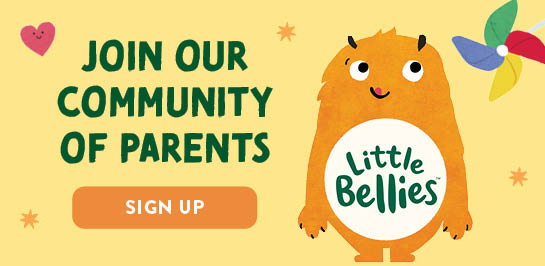Feeding Schedule for an 8 Month Old Baby
Reading time:
Reading time:

By: Dahlia Rimmon MS, RDN
Your baby is 8 months old; you’ve finally nailed the milk feeding routine, and starting solids is off to a great start—it feels like you’re finally getting the hang of the whole parenting thing. But as your baby grows and starts eating more, between milk feeds and solid food, some days feel like you’re running a round-the-clock feeding buffet. You’re bouncing from breast to breakfast, then bottle to lunch, back to breast for dinner, and before you know it, the day is over and it’s time to start all over again.
At 8 months old, babies are busy exploring new foods, strengthening their feeding skills, and ready to take on more chewable foods. But what should an 8 month old feeding schedule look like? How do you balance solid foods with milk feeds? How often do they really need to eat? To help answer your questions and give you a boost of confidence at mealtime, we’re sharing everything you need to know about feeding your 8 month old baby.
When you start introducing solids to your baby, you have a few choices on how to begin. You can start with single-ingredient purees, try a baby-led weaning (BLW) approach with soft finger foods, or follow a combination of both methods. Every baby is different, and each family has different needs–choose an approach that works best for you and your baby.
When starting with purees, focus on offering a wide variety of foods with different flavours and textures. Even though each food is blended, they still provide unique tastes and textures, giving your baby a diverse introduction to foods right from the start. Once your baby is comfortable with smooth purees, gradually progress to mashed foods and chunkier textures.
Aim to introduce finger foods before your baby reaches 9 months, since it may be more challenging for them to adjust to new textures after this age. By 8 months, your baby has been exploring solid foods for about two months and is becoming a more confident eater, so it’s a great time to advance textures and introduce finger foods.
When following a BLW approach, it’s important to offer foods that babies can easily pick up. By 6 months, babies can pick up larger foods with their whole hand using the palmar grasp. Around the 8 or 9 month mark, you’ll notice your baby developing the pincer grasp, enabling them to pick up small pieces of food with their index finger and thumb. You can offer your 8 month old both shapes of food at mealtime.
When cutting food for babies who haven’t developed the pincer grasp yet, make sure the pieces are easy to grab with their whole hand or palm. Cut foods into spears or sticks that are long enough to stick out of your baby’s palm. If the pieces are too short, your baby may have trouble taking bites, which could lead to some tiny, adorable frustration.
Here are some examples of foods that are safe for self-feeding at 8 months:
Your 8 month old might be experimenting with the pincer grasp by now. When you see this, cut food into small bite-sized pieces to help them practice this new skill. Remember that small, round foods can be a choking hazard because they can get lodged in the oesophagus. To reduce the choking risk, cut round foods in half or quarters lengthwise, or flatten or smash them so that they are no longer circular.
If your baby hasn’t started showing signs of the pincer grasp yet, that’s perfectly fine. Every baby develops at their own pace, and your baby may start practicing it closer to 9 months.
Here are some examples of foods that can be picked up using the pincer grasp:
Finger foods, no matter their shape, should be soft enough that you can easily squish them between your fingers. Hard foods like raw carrots, apples, or celery can pose a choking hazard, as well as foods that are sharp, gummy, or sticky (like thick, globby peanut butter). These foods should be modified for safety before giving them to your baby.
Regardless of whether you started solids with purees or finger foods, you can still adopt a baby-led approach to feeding. This means allowing your baby to take the lead and encouraging them to self-feed rather than relying on spoon-feeding from parents. Purees can be offered for self-feeding by pre-loading a utensil (preferably one designed for self-feeding) and encouraging your baby to bring it to their mouth. Thicker, scoopable purees like oatmeal, mashed potatoes, Greek yoghurt, or coconut rice can be served directly on a high chair tray. This allows babies to scoop up these foods with their hands, no utensils are needed.
It’s a great time to introduce two solid meals to your 8-month-old baby’s feeding routine. Babies at 8 months old will still get most of their nutrition from milk feeds, so continue with their usual amount of milk and add in two solid meals each day. When it comes to food quantities, there’s no strict serving size to follow. Babies are excellent self-regulators—they’ll eat when they’re hungry and stop when they’re full. Allow your baby to eat as much or as little as they want.
You’ll recognise when your baby is hungry when they bring food to their mouth, point to more on the counter, or smack or lick their lips. When they’re full, they’ll turn their head away from the utensil, no longer feed themselves, firmly close their mouth, or become easily distracted or irritable in the high chair. If your baby isn’t eating much, spits out food, or throws food on the floor, don’t stress too much. Since most of their calories come from milk feeds, any shortfall in solid food will be balanced out with milk.
We want babies to have enough room in their little bellies for both milk and solid feeds, so it’s best to offer them at separate times during the day. We recommend spacing out milk and solid feeds by 45 to 120 minutes. If you offer them back-to-back, they might not have sufficient stomach space to eat enough of both. Keep in mind that every 8-month-old feeding schedule may be different—some babies need less than an hour to digest and make room, while others might need two hours or more.
Feeding babies solid food takes more time, energy, and patience compared to milk feeds. To ensure a successful feeding session, schedule solid feeds when your baby is well-rested, focused, and not overly hungry.
Here are a few examples of an 8 month old feeding schedule that includes both solid and milk feeds, along with naps. At this age, babies typically have about 6 to 8 milk feeds in a 24-hour period and take two naps a day. Keep in mind that every baby is different, so the number of milk feeds can vary based on factors like growth spurts, comfort nursing, and how much solid food they eat.
6:00 AM: Wake up + milk feed
7:15 AM: Solid food
8:00 AM: Milk feed
9:00 AM: Nap
11:00 AM: Milk feed
12:00 PM: Solid food
1:00 PM: Milk feed + nap
3:00 PM: Milk feed
5:00 PM: Milk feed
7:00 PM: Milk feed + bedtime
7:00 AM: Wake up + milk feed
9:00 AM: Nap
10:00 AM: Milk feed
11:00 AM: Solid food
1:00 PM: Milk feed + nap
4:00 PM: Milk feed
5:00 PM: Solid food
7:00 PM: Milk feed + bedtime
11:00 PM: Milk feed (dream feed)
6:30 AM: Wake up + milk feed
7:30 AM: Solid food
8:30 AM: Milk feed + nap
10:30 AM: Milk feed
12:30 PM: Milk feed
1:30 PM: Solid food
2:30 PM: Milk feed
4:30 PM: Milk feed
6:30 PM: Milk feed
8:30 PM: Milk feed + bedtime
It’s totally fine if your baby’s schedule doesn’t match these examples. These are just sample feeding schedules for 8 month old babies. Every family follows their own unique schedule, and factors like illness, bedtime, nap lengths, and your own needs can influence their feeding routine.
We recommend serving your 8 month old 2 to 3 different foods at each meal to avoid overwhelming your baby with too many choices. We also recommend serving small portions of food to prevent visual and sensory overload. If your baby finishes food and wants seconds (or thirds!), you can always refill their plate or tray.
When planning your 8-month-old baby meals, try to balance out the nutrition from different food groups. Instead of sticking to a carb-heavy menu like fruit, toast, and veggies, make sure to include proteins and healthy fats too. This not only introduces a variety of nutrients but also keeps your baby feeling satiated, and more energetic between meals, and keeps their blood sugar levels steady.
With that in mind, here are a few examples of daily menus featuring various food groups for 8-month-old babies:
Wholesome baby snacks are a great opportunity to add extra nutrition to your baby’s diet. Although your 8 month old is eating two meals a day, there are days when they might be extra hungry, or you might need a quick snack to throw in your diaper bag when you’re on the go. Plus, if older siblings are enjoying snack foods, involving your baby in snack time can create wonderful family bonding opportunities.
Snacks are essentially mini meals – just smaller versions of breakfast, lunch, and dinner. Ideally, baby snacks should be homemade using whole foods like fresh produce, lean proteins, and whole grains. Homemade snacks won’t have any unnecessary additives, and you have control over the ingredients, so you know exactly what your baby is eating.
However, there are times when you need to rely on packaged snacks for convenience, like when you’re traveling or on those hectic, busy days. When offering your baby packaged snacks, it’s important to check the ingredient list, especially for sugar and salt content. Watch out for sneaky sources of added sugar like brown rice syrup, high fructose corn syrup, cane sugar, and molasses. It’s also important to be mindful of salt content, as babies have developing kidneys and may struggle to process excess sodium. Fortunately, brands like Little Bellies offer snack foods that meet healthy guidelines perfectly!
Little Bellies offers a range of baby and toddler snacks that are organic, non-GMO, and free of added sugars and salt. Through exposure to taste, textures and shapes, Little Bellies helps babies develop oral-motor skills and familiarity with food. Start by introducing Little Bellies Pick-Me Sticks (7+ months) in yummy strawberry and banana flavours. Then move on to the Little Bellies Yogurt Pick-Me Sticks (10+ months) available in delicious berry and mango flavours. Once your baby is familiar with and enjoying those fruity flavors, leverage their familiarity to introduce fun new shapes like Little Bellies softcorn in Berry-Apple flavour, which will also further define their pincer grasp skills.
Here are some homemade baby snacks for 8 months:
As you enjoy meals with your child, the best advice we can give – along with providing a healthy balanced diet – is to create happy memories. When your baby sees you enjoying your food and feeling content at mealtime, they will mimic your behaviour and energy at the table. Involve your baby in meal preparation, whether it’s babywearing while you cook, taking them to the farmers market to explore fruits and vegetables, or simply bringing them to the table with you while you eat. Show them how you chew and swallow, as babies learn a lot through observation and imitation. Include your baby in family meals and offer them similar foods (modified as needed) whenever possible. Most importantly, have fun at mealtimes. Let your baby dive in and get messy with their foodie. Enjoy this adventure!

Let’s Make It Official
Get the latest news on parenting tips, food play hacks, promotions and giveaways!
Subscribe Now